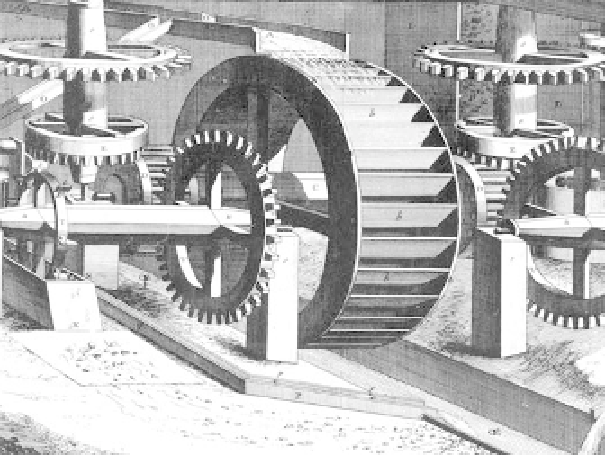Environmental Engineering Reference
In-Depth Information
7.5
(a) Horizontal waterwheel (Ramelli 1588). (b) Overshot
wheel (Diderot and D'Alembert 1751-1772).
of them as recently as 1925 (Holt 1988; Muller and
Kauppert 2004). Waterwheels reached their greatest
prominence during the decades of early industrializa-
tion, and many systematic accounts of them exist, includ-
ing Bresse (1876), Bennett and Elton (1898), M¨ller
(1939), P. N. Wilson (1956), Moritz (1958), Forbes
(1958; 1965), Hindle (1975), Fox, Brooks, and Tyr-
whitt (1976), Meyer (1975), L. White (1978), T. S.
Reynolds (1983), and W
¨
lfel (1987).
The basic typology of vertical waterwheels is straight-
forward. The kinetic energy of low-gradient streams
(with heads of 1-3 m) was exploited by undershot
wheels, first built with simple radial boards, later with
the backs preventing water from shooting over the floats.
Their efficiency could be further improved by forming
the base below the waterwheel rim into a closely fitting
breast over a 30
arc at the bottom center to increase
water retention. This was particularly important in
curved-blade wheels, which were introduced around
1800 by Jean-Victor Poncelet as the most efficient un-
dershot machines. Wheel diameters were roughly three
times as large as the water head for paddle wheels and
two to four times for Poncelets. Locating them on swift
currents was desirable because the theoretical power of
undershots is proportional to the cube of the water speed
(doubling the speed boosts the capacity eightfold).
Breast wheels combined the kinetic energy of the flow-
ing water, which entered roughly at the level of the axis,
with gravitational energy for heads between 1.5-5 m.
Low-breast arrangements, with water entering below






